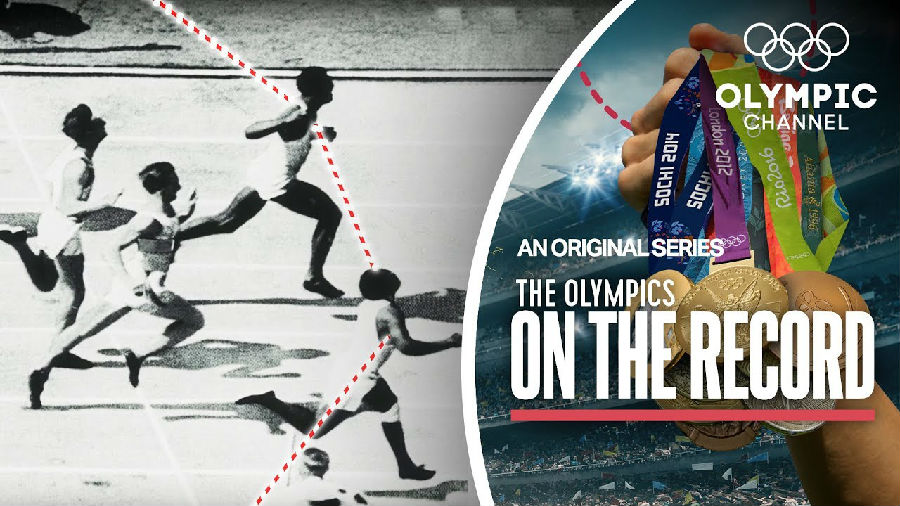(单词翻译:单击)
The average human reaction time is between two tenths and three tenths of a second.
普通人的反应时间是0.2到0.3秒之间。
The average reaction time of an Olympic athlete is a bit quicker, not surprisingly.
奥运选手的平均反应时间毫无疑问是相对快一点的。
But the fact is that, when you're using a stopwatch, there will always be a small but significant difference between the moment the gun goes off and the moment the thumb hits the button.
但是事实上,当你使用秒表的时候,枪响和扣动扳机之间总会有一些细微但显著的时间差出现。
It's just human nature.
这就是人类的本能。
And yet it was the stopwatch - this human-operated instrument, not-quite accurate - that recorded Olympic events right up to the 1960s.
但人们直到上世纪60年代才不再使用这种由人操作的、不太精确的秒表来记录奥运赛事。
A moment of human distraction could make a serious difference to the official results.
人们短暂的分心都会对真正的结果产生重大影响。
Nowadays, we take it for granted that races are automatically timed with precision, measured to within a hundredth of a second, sometimes a thousandth of a second.
现在,我们理所当然地认为比赛是自动计时的,精确到百分之一秒以内,有时甚至是千分之一秒。
So today, we're able to test the speed and reaction time of the athletes, not the timekeepers.
如今,我们可以测试运动员的速度和反应时间,而不是计时员的。
There were other limitations to using stopwatches.
使用秒表还有其他的一些局限。
At the first Olympic Winter Games in 1924, timing ski races over long distances, at high altitude, presented a real challenge.
在1924年第一届冬奥会上,长距离、高海拔地区的计时滑雪比赛是一个真正的挑战。
The most sophisticated solution they could find was to use two coordinated stopwatches - one at the top and one at the bottom - to record start times and finish times.
他们能想到的最精确的解决方案是协调使用2块秒表——一个在顶端,一个在底部——来记录开始时间和结束时间。
But with no telephones on the mountain to communicate the data from top to bottom, that meant that the race would have to be completed and the figures calculated before anyone had any idea who had won.
但山上没有电话,无法进行数据通信,因此在比赛结束、数据计算出来之前,没人知道究竟是谁赢得了比赛。
Trying to think of the quickest way to get the information from top to bottom, one timekeeper came up with a creative solution.
为了尽快收集到信息,计时员提出了一个很有建设性的解决办法。
So ... this is your start time - if you could give it to the timekeeper at the bottom of the hill, that would be marvellous.
所以……这是开始时间——如果你能把它交给山脚下的计时员,那就太好了。
And ready, set, go.
准备、设置好时间、开始。
Pip-pip!
哔哔!
Olympic timekeeping has come a long way since those days, and one key piece of technology has vastly improved the science of measuring victory - the photo-finish.
从那时起,奥运计时经历了漫长的发展道路,其中一项关键的技术极大地提高了衡量胜利的科学性——那就是终点摄影。
The idea of using a camera to record the winner was first developed in horse racing in the 1920s.
用照相机记录获胜者的想法最早出现在20世纪20年代的马术比赛中。
The photo-finish camera records not the distance between the runners, but the visual time in 50ths of a second.
终点摄影机记录的不是跑步者之间的距离,而是一秒的五十分之一。
In the real photo-finish box, shutters over the windows transform it into a darkroom.
在真实的终点摄影机箱里,快门将它变成了一个暗房。
Into the developing tanks goes the picture, which, if the judges have disagreed, will settle the result beyond all argument.
照片在显影容器中形成,即使裁判对此有异议,也会据此来判定结果。
And here's the finish, 30 seconds after the race is over.
比赛结束30秒之后就会出来了。
Hard luck, chum, but the camera can't be wrong.
只能说运气不好,朋友,但照相机不可能出错。
The photo-finish was first used at the Olympic Games in Los Angeles in 1932.
1932年洛杉矶奥运会上首次使用了终点摄影。
The men's 100m final would come down to two American sprinters - Eddie Tolan and Ralph Metcalfe.
男子100米决赛冠军在2名美国选手埃迪·托兰和拉尔夫·梅特卡夫之间产生。
A hundred-metre dash.
百米短跑。

Yoshioka snaps off first and that's Tolan sprinting to the front now.
吉冈首先落后,现在是托兰在前面。
He's ahead, Metcalfe a foot behind.
他在前面,梅特卡夫落后一步。
Now Tolan and Metcalfe seem even.
现在托兰和梅特卡夫看起来是一样的。
Can you tell who won? Both were given the same time - 10.38 seconds, using a stopwatch, of course.
你能分辨出谁赢了吗?两人的时间是一样的——10.38秒,这自然是用秒表计的时。
The photo-finish eventually determined the correct winner.
终点摄影确定了真正的赢家。
Tolan wins. The world's record of ten and three-tenths seconds.
托兰赢了,他创造了10.3秒的世界纪录。
The world's fastest humans.
他被称为世界上最快的人。
Tolan first and Metcalfe second, both of the United States, and Arthur Jonath of Germany third.
托兰第一,梅特卡夫第二,两人都来自美国,德国的亚瑟·乔纳斯位列第三。
But there was a snag.
但是有一个问题。
Developing film was a complex art, and it took a while in the darkroom.
冲洗胶卷是一项复杂的技术活,这需要在暗房里花费一段时间。
A long while.
其实是很长一段时间。
It was several hours later before the timekeeper was able to declare Eddie Tolan the winner.
几个小时之后,计时员才宣布埃迪·托兰获胜。
He was deemed to have got his entire body across the line first.
他被判定为整个身体都越过了终点线的第一个人。
In more modern times, the winner is the first athlete to cross the line with any part of his or her body.
在近代,获胜者是第一个用身体任何部位越过终点线的运动员。
Judged by modern rules, Metcalfe, not Tolan, would have won.
根据近代的裁定依据,是梅特卡夫赢得了比赛,而不是托兰。
But those are human rules and human interpretations.
但这些都是人定的规则和人为的解释。
Another day of the Olympic Games and there's no let-up in the game competitions before huge crowds, despite the London mist.
到了另一个时代的奥运会,尽管伦敦大雾弥漫,但在众多的人群面前,比赛不能有一刻的放松。
By the London 1948 Olympic Games, the technology had moved on again.
到了1948年伦敦奥运会,技术开始向前发展。
Timekeepers managed to get the photo-finish result out in less than 90 seconds - quite an achievement in those days of pre-digital technology.
计时员成功地在90秒内拿到了终点摄影照片,这在前数字技术时代是一个相当大的成就。
On their marks, set, and they're off. With Dillard on the outside, getting away in front.
根据他们的标记设置,然后离开。画面之外的迪拉德走在最前面。
Now, as we watch the race in slow motion, left to right, it's Dillard, Bailey, McCorquodale, La Beach, Ewell and Patton.
现在,我们以慢动作观看比赛,从左至右依次是迪拉德、贝利、麦科克代尔、拉比奇、尤厄尔和巴顿。
Dillard still holds his lead, with Ewell resolutely closing down.
迪拉德仍然保持领先,尤厄尔正在渐渐逼近。
At the tape, it's a photo-finish.
在磁带里,这是终点摄影。
The winner was clear enough.
获胜者一目了然。
But the photo-finish was required to award the bronze medal and the silver medal.
银牌和铜牌获得者也需要借助终点摄影才能得知。
Again, the photo-finish was really showing its worth.
再一次,终点摄影证明了它的价值所在。
Let's do our own photo-finish.
我们来拍终点摄影吧。
Yeah, let's do it.
嗯,我们开始吧。
Have I got something in my teeth?
我牙齿上有东西吗?
Digital cameras today capture images at 10,000 frames per second, allowing instant photo-finish results.
今天的数码相机可以在1秒内捕捉1万帧图像,可以即时看到终点摄影结果。
No Olympic Games goes by without several races coming down to a nail-biting, thrilling - but perfectly accurate - photo-finish.
历届奥运会上都会有几场扣人心弦的,或者更确切地说,是得靠摄影机来定胜负的比赛。


